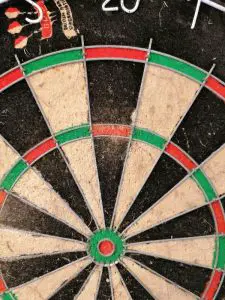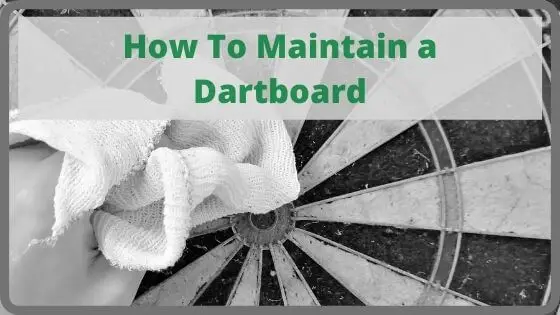If you’ve invested in a new dartboard, or have a high-quality board like a Winmau Blade 5 then the last thing you want is to see it deteriorate and lose quality after some practice sessions!
There are times when I neglect dartboard maintenance and if I’ve had some particularly long practice sessions, the board just ends up looking tired, worn, and barely playable. There are few things worse in darts than playing on a worn-out dartboard.
There’s something satisfying about hitting a fresh-looking treble so keeping your dartboard in good condition is not only important for getting good value and longevity from your board but also for enhancing your practice time and sessions.
Dartboard maintenance definitely seems like a boring term but in this article, I’ll show you how to maintain a dartboard, how quick and easy it can be, and also why it’s going to be beneficial to your game in the long term… Because it will be!
The 7 best ways to maintain a dartboard are:
- Ensure dartboard is properly setup
- Regular cleaning
- Rotate the dartboard
- Keep dart points sharp
- Keep your dartboard indoors
- Keep your dartboard dry
- Avoid harsh lighting
How To Maintain a Dartboard
Below, I’ve pulled together a list of 7 key ways to maintain a dartboard. Some will only take a few minutes and you don’t need to do them all at once but by ticking off the items on this list, you’ll ensure your board stays in great condition for years of practice.
I’ve had boards stay in good condition for 5 – 10 years so it’s definitely worth investing your time in proper dartboard maintenance!
1. Ensure the Dartboard Is Properly Setup
Your first step in dartboard maintenance should be ensuring that the dartboard is secured mounted and properly setup. Most dartboards will come with mounting holes and instructions to help to securely mount or hang your dartboard.
These mounting points are made to ensure your dartboard can be secured while evenly distributing the weight of the board. If you don’t follow the manufactures assembly instructions, it’s likely that the weight of the board will not be evenly distributed and you risk the dartboard falling off during use.
Dropping a dartboard is the easiest way to damage it, break the wireframe, or permanently dent the sisal fibers so ensuring your dartboard is secure and properly mounted should be your first priority with dartboard maintenance.
2. Regularly Clean the Dartboard
While this step is important, it’s also one where people go wrong and end up causing more damage to the board instead of maintaining it! Cleaning your dartboard regularly is important but you need to make sure you clean it correctly.
There are different types of dartboard with the most common materials being used as follows:
- Wood
- Cork
- Sisal Fiber
- Plastic (electronic dartboards)
Each of these dartboards requires different cleaning techniques. You can’t clean a dartboard using the same method as what works for one could seriously damage another type of board. Take the wooden log-end dartboard as a good example.
This board used in Manchester, UK is made from wood and therefore needs to be soaked in warm water to prevent the wood from drying out, cracking, and forming holes in the board. This is therefore an essential cleaning technique.
If you soak a sisal dartboard, however, you’ll damage the glue that holds the sisal fibers in place which will then lead to holes and bumps in the board. As you can see, what works for one board will not necessarily work for another but all boards will still need to be cleaned in some way.
To see the best way to clean a dartboard (including all different types) you can check out my guide found here > https://decentdarts.com/how-to-clean-a-dartboard/
3. Rotate Your Dartboard
For me, rotating your dartboard regularly is the single most important thing you can do to maintain your dartboard and keep it looking fresh and clean.
The reason is very simple, once you get fairly accurate and consistent with your dart throw, you’ll start to really test the board’s sisal fibers.
How?
Well, each time your dart hits the board it pushes the sisal fibers apart. Modern dartboards have a good bounce-back aspect where the fibers will revert to their original position but the more accurate you are – especially around the treble 20 – the more likely it is that the fibers won’t have time to keep their shape.
This leads to holes forming around the practice area and can even lead to your dartboard bulging or becoming lumpy.
I’ve not rotated my dartboard in around 4 weeks and just look at the picture below to show the kind of damage that occurs when you don’t rotate your dartboard:

Rotating your dartboard only takes a few minutes but will increase the longevity of your dartboard helping it lasts 10 times longer.
That’s not a random number I’ve selected either. There are 10 black/red segments so assuming you practice treble 20 a lot, with regular rotating you have 10 segments to work through repeatedly before your board suffers any long-term damage.
Therefore, rotate your board every few weeks to make it last 10 times longer.
4. Keep Your Darts Sharpened
While this may seem counterintuitive, blunt darts will cause more damage to your dartboard than a sharpened dart will. Therefore, one key way of maintaining your dartboard – without actually doing anything to the board – is to keep your darts sharpened.
** Don’t know how to sharpen your darts? Check out my guide to sharpening a dart here.
As a blunt dart enters a sisal fiber dartboard, the rounded tip with a larger surface area will flatten the fibers in a certain area rather than landing between them and pushing them apart.
With a relatively sharp dart, the dart will move the fibers aside on contact with the board allowing them to move back to their original position when the dart is removed.
Blunt darts do not allow this type of board recovery and therefore keeping your darts sharp is key to a long-lasting board. To test the sharpness, run your finger along the tip of the dart. If it feels smooth to the touch, the point of the dart is blunt.
You also need to check for dart burrs regularly as these are the most important thing when it comes to sharpening a dart. A burr is a folded tip causing the dart to have a hook-like feel when you run your finger over the tip.
These hooks/burrs will pull the fibers out of the board when you remove your darts after a throw so you need only need to sharpen your darts to prevent blunting but also to prevent burrs, both of which can easily damage a dartboard.
5. Keep Your Dartboard Indoors
While darts are predominantly an indoor sport, you can play darts outside if you want to. The issue? Dartboards are not really manufactured for outdoor use.
While some dartboards can be quite weather-resistant – plastic, non-electronic boards mainly – the majority do not offer any form of weather resistance.
Rain, humidity, direct sunlight, and wind (depending on where your dartboard is mounted) can all be damaging to a dartboard and some of these factors listed above can even be damaging to your board immediately.
While I won’t bore you with the exact reasons why, as many are already covered in other sections of this article in terms of water or light damage, the easiest solution is to keep your dartboard for indoor use only.
This is the easiest way to ensure the environment and weather don’t destroy your board without you even realizing it.
6. Keep Your Dartboard Dry
I touched on this early but a very important aspect when it comes to dartboard maintenance is keeping your dartboard dry. There are three ways your dartboard can be damaged by water (unless it’s a wooden board):
- Cleaning with water
- Soaking a dartboard in water
- Moisture in the environment
The first two can easily be avoided and after reading this article, hopefully, you’ll stay clear of wetting your dartboard when it’s not necessary or recommended. It’s the final point that most won’t be aware of and that is moisture in the playing area.
Depending on where you live, most people will experience some damp or moisture in their homes. It’s one of those dreaded things that often come out of nowhere but if you have a board in a room that’s prone to moisture, you could be damaging your board without even realizing it.
Therefore, set your dartboard up in the driest room in your home and look into a dehumidifier to ensure any excess moisture in the atmosphere is not being soaked up by your board.
Test it for yourself, you’d be surprised by how much moisture might be in the same room as your dartboard and slowly (but surely) ruining it.
7. Avoid Harsh Dartboard Lighting
This is a point very few people consider but strong lighting, especially when it’s kept close to your board can actually be damaging.
The reason for this is because the heat from the light can either warp the dartboard if it’s wood or cork or it can melt the glue holding the sisal fibers in place for a regular sisal fiber dartboard.
Some people will opt for a budget option when it comes to dartboard lighting and uses some regular bulbs or lamps to provide light when throwing. In some cases, people will go too far overboard and invest in a huge lighting system to make their board the centerpiece in a room.
The issue with this approach is that certain light sources let off a lot of heat and as mentioned above, this can quickly and easily damage your board in the short term.
If you are going to light your board, either use a light source that is positioned roughly 1 meter away from the board or opt for some dedicated dartboard lights like the Target Corona Vision or a more budget-friendly option like the Viper Cabinet Mounted Display Light.

You can check out both of the above in our in-depth review and roundup of the best dartboard lights.
How Long Will a Dartboard Last
The length of time that a dartboard will last will depend on a number of factors. The type of dartboard, how often you practice, and most importantly – how you maintain your dartboard, will all determine how long a dartboard will last.
If we assume that you are following the above dartboard maintenance tips, then a dartboard will last for 2 – 3 years for those that practice daily (for up to 1 hour), or it will last for 4 – 5 years for those that play less frequently (1 – 2 times per week).
An electronic dartboard can last for 10+ years even with regular use due to a hard-wearing plastic construction that is easy to clean and long-lasting. The batteries and parts may need to be replaced every few years though.
In Summary
Dartboard maintenance is a pretty boring part of the game of darts, but one that is necessary.
The reason dartboard maintenance is important is because you want your board to stay in good condition and last for as long as possible to provide value for money and an enjoyable darts experience.
While all of the above don’t need to be done at the same time or with any real diligence, you should look to do a few of the steps every few weeks, especially for those practicing daily.
If you follow the steps above, you should expect a standard bristle dartboard to stay in good condition for 3 – 5 years depending on how regularly you practice and of course, how regularly you maintain your board!

